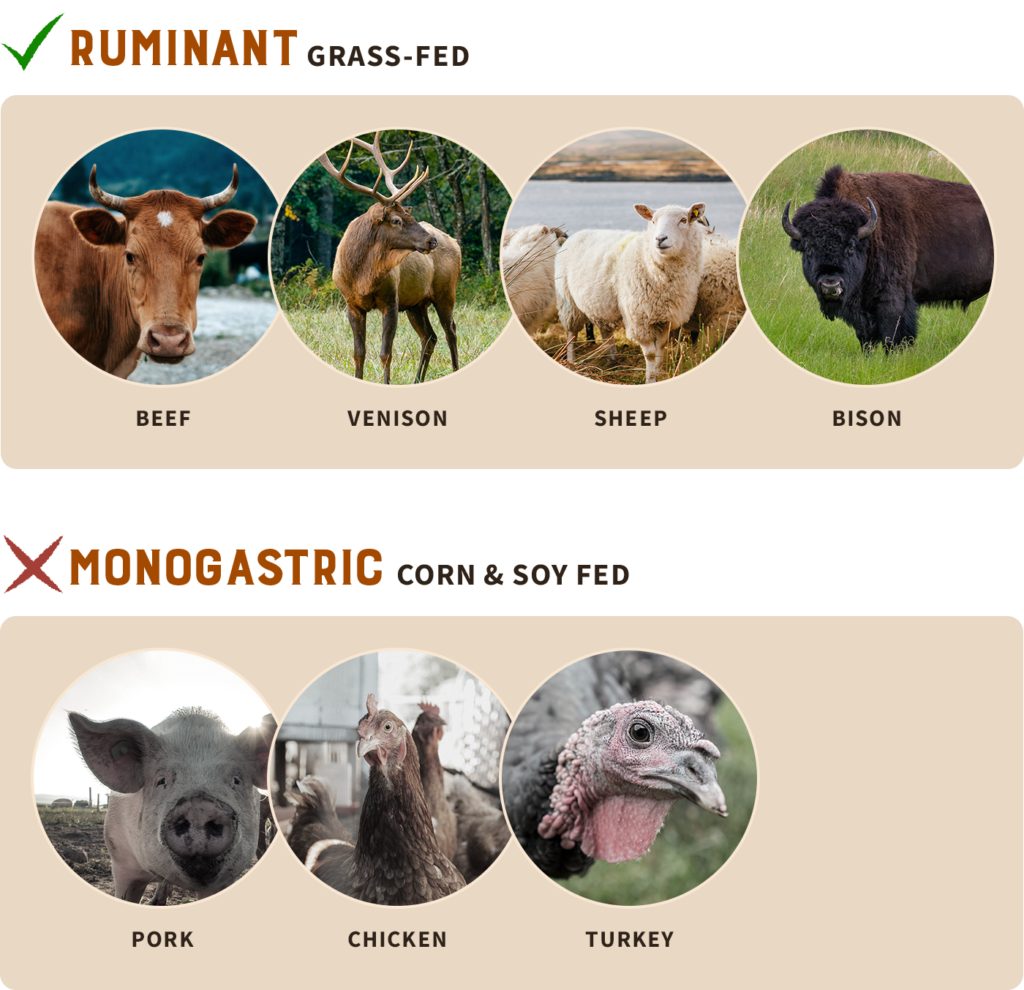Are you curious about the animal-based diet but need help figuring out where to start? We’ve got you covered.
There’s so much conflicting information out there when it comes to diet and lifestyle. Sifting through the noise and finding what works best for you can be incredibly confusing. Everyone has different backgrounds and health concerns, so we’ll share fundamental principles that have helped thousands improve their well-being so you can do the same.
In this article, we’ll answer questions like:
- How do I get started on an animal-based diet?
- Should I do the carnivore diet or animal-based?
- What fruits and vegetables should I focus on?
- How much should I eat each day?
- Why should I include organ meats?
As a bonus, we’ll also cover lifestyle suggestions to consider alongside your diet, including sleep, exercise, stress management, and other areas that can dramatically impact your health goals.
Off we go!
Diet Considerations
First, let’s differentiate between carnivore and animal-based diets…
What is the Carnivore Diet?
The Carnivore Diet is a low or no-carb diet that primarily focuses on animal foods such as meat, eggs, and organs. Some carnivore diets include carbohydrates in minimal amounts through milk or cheese.
We believe that a strict carnivore or ketogenic diet can be strategically beneficial for about 30 days under specific circumstances (and under supervision of a health professional).
Some circumstances may include transitioning from a very unhealthy diet, combatting an autoimmune illness, rectifying metabolic dysfunction or used as an “elimination diet” approach followed by slowly incorporating foods back into your diet.
If you’re looking for a more in-depth explanation of the Carnivore Diet, visit this article.
What is an Animal-Based Diet?
For optimal health, longevity, and performance, we suggest a properly constructed nose-to-tail, animal-based diet that includes organs and low-toxicity plant foods (more on this below).
A properly constructed, nose-to-tail, animal-based diet consists of high-quality meat, organs, fruit, honey, raw dairy (if tolerated) and eggs (checkout Angel Acres Farm for Low Pufa, corn and soy free, pasture raised eggs). These foods have been treasured throughout human history, and countless people have thrived on them! Check out this podcast, where Paul Saladino MD discusses the basics of food inclusions and exclusions on an animal-based diet.
Some benefits many of our client’s experience when including low-toxicity carbs into their diet are proper and balanced hormones, improved sleep quality, consistent energy, and enhanced performance and recovery. This discussion also offers valuable insight into carbohydrate benefits and the potential pitfalls of the ketogenic diet.
Why Should I Eat Animal-Based?
We commonly work with people looking to improve autoimmune illness, lose weight, support a healthy pregnancy, or improve mental health. Many people come from ketogenic, carnivore, paleo, or plant-based diets because they can be too restrictive or haven’t yielded the intended results. In addition to solving endless health concerns, an animal-based diet is simply what humans have become adapted to eating over the course of our evolution.
That said, let’s take a closer look at the fundamental principles to keep in mind when constructing an animal-based diet.
What Type of Meat is Best on an Animal-Based Diet?
Your diet should focus primarily on grass-fed ruminant animals such as cattle, buffalo, goat, lamb, and deer. We suggest cutting out meat from animals that are primarily fed corn or soy. Companies like White Oak Pastures and US Wellness Meats offer great grass-fed options.

Conventionally raised beef, chickens, pigs, turkey, and ducks (even the organic labeled animals) are often fed “organic” corn and soy, which is damaging to our health.
Unlike ruminant animals, monogastric animals (such as humans) can’t eliminate excess amounts of linoleic acid (polyunsaturated fatty acids or PUFAs, also found in vegetable oils) from their diets, accumulating in their fat cells over time.
When consumed in excess, this molecule can be highly damaging to our mitochondria leading to inflammation and chronic disease if not appropriately addressed.
If including various animals in your diet is still desired, companies like Nourish Food Club or Nose To Tail intentionally sell low-PUFA options to alleviate this excess consumption. Eat Wild is another fantastic resource for finding high-quality meat in your area.
Additionally, eating fish no more than twice a week (or less) is ideal, even if it’s wild-caught. Fish is undoubtedly rich in bioavailable nutrition, but we don’t suggest consuming it in excess due to the known accumulation of toxins in these animals (1, 2).
The Importance of Organs
We are huge fans of eating nose-to-tail and incorporating organs into our diets (surprising, we know). The unique nutrients contained within liver, heart, bone marrow, spleen, pancreas, and other organs are part of our ancestral heritage and contain vital nutrients.
Many of the unique nutrients in organs are not found in significant amounts in muscle meat or plant foods, so adding organs into your diet provides essential nutrients for optimal health.
Fresh organs are amazing, but getting enough into the diet is challenging for many people. Some don’t like the taste or texture, while others have trouble sourcing or traveling with them. We created Heart & Soil for this exact reason—to help as many people as possible benefit from the deep nutrition contained within these foods.
We suggest that people eat 1-3 ounces of organ meat daily. Liver, heart, and bone marrow are generally the most accessible options and can be found at your local farmers market or Whole Foods.
Carbohydrates: Friend or Foe?
As mentioned above, carbohydrates from specific sources are a crucial component of the animal-based diet. The most popular sources are:
- Organic fruits that are in season (and fresh fruit juices)
- Raw Honey
- Milk
- Cheese
- Maple Syrup
Many also consume organic sweet potatoes and white rice without issue. Check out our animal-based infographic for a visual representation of the foods we suggest prioritizing!

At this point, you may be asking, what about vegetables? As Paul Saladino MD described throughout The Carnivore Code, many plant foods don’t want to be eaten. To protect themselves, they produce defense chemicals that can harm our health, especially if consumed excessively.
These compounds may contribute to autoimmunity, neurological issues, digestive issues, joint pain, and more. The plant foods we suggest you should avoid are leaves, stems, roots, and seeds (nuts, grains, legumes).
The Role of Dairy
Dairy can be another key addition to your animal-based diet.
When people react negatively to milk products, the offending component is often a protein called ‘casein.’ There are two varieties of milk out there; A1 and A2, which refer to the type of casein protein found in the milk. A1 casein is contained in most cows’ milk in the United States, and the A2 variant occurs in the milk of a small percentage of US cows and other ruminants like buffalo, goats, and sheep.
In our opinion, raw, unpasteurized milk from grass-fed cows is one of the few things on this planet genuinely worthy of being called a superfood. Not only does it provide fat- and water-soluble vitamins in their most bioavailable forms (3), but it also contains enzymes, bacteria, and unique peptides that can improve digestion, microbial diversity, and overall health (4)(5).
Raw dairy isn’t always accessible, but it’s our preferred dairy source, as Paul Saladino MD explains in this video. You can find raw milk in your area through RealMilk.com. This Instagram post highlights other options if you can’t purchase raw milk.
Eliminate Vegetable Oils
A vital piece of the animal-based diet is avoiding vegetable oils that wreak havoc on the human body. This is a difficult task because they are everywhere within the modern Western diet. Nearly every processed food contains vegetable oils, and almost every restaurant uses them to cook.
To name a few, we suggest eliminating the following:
- Canola Oil
- Safflower Oil
- Sunflower Oil
- Soybean Oil
- Grapeseed Oil
- Sesame Oil
These oils contain an unnaturally high amount of polyunsaturated fatty acids, and we believe they are the primary driver of metabolic dysfunction (as described throughout this playlist).

Instead of seed oils, opt for tallow, butter, or ghee.
Olive oil, avocado oil, and coconut oil are nowhere near as bad as vegetable seed oils but contain compounds such as oleosin and salicylates, which can irritate sensitive individuals.
If you consume olive or avocado oil, make sure you purchase them from reputable sources. Many brands at the grocery store cut their products with soybean, canola, or other seed oils (6).
Now, let’s take a look at additional details that are helpful to know when following an animal-based diet.
How Much Food Should I Eat?
Counting calories is not required, as our main focus tends to be macronutrients (protein, fat, and carbs). But if you wish to track your intake, Cronometer or MyFitnessPal are great tools to keep on hand. This calculator also helps determine your ideal macronutrient intake.
In most cases, you should aim for 1-1.2 grams of protein per pound of goal body weight. Generally, one pound of meat (454g) contains about one hundred grams of protein.
Your fats should ideally come from sources that contain stearic acid – a crucial fatty acid that will help turn those mitochondria “on” and shift them into a “fat-burning” mode. It can also aid satiety, weight loss (7), and proper hormone function (8).
The best sources of stearic acid are grass-fed, grass-finished 80/20 ground beef, fatty steaks, suet, bone marrow, tallow (or our Firestarter supplement), ghee, or butter.
Here are the macronutrient targets we find work well for most people:
- Protein = range of 1-1.2 grams x ideal body weight
- Fat = 0.8-1 grams x ideal body weight
- Carbs = 0.7-1.2 grams x ideal body weight
As an example, someone with a goal body weight of 150 lbs may have macronutrient values similar to this:
- Protein = 150-180 grams
- Fat = 120-150 grams
- Carbohydrates = 105-180 grams
Regarding your fat and carbohydrate intake, if your total activity level is on the lower end, you might experiment with the lower end of the range, but if you are more active, you could try the higher end. Don’t get too caught up with exact numbers; aim to experiment within the ballpark!
* Please note: Those looking to correct metabolic dysfunction may benefit from 90-120g of carbohydrates daily (or less). We also suggest working with a healthcare professional to monitor your progress*
Tips for Constructing Your Meals
We don’t offer personalized meal plans at this time, but here are some amazing resources for meal ideas, recipes, and more:
- The Carnivore Code Cookbook
- Whole Foods Grocery Haul with Dr. Paul
- Dr. Paul’s Typical Day of Eating
- Animal-Based Recipes from Ashley Rothstein
Fasting and Meal Frequency
We routinely get asked about meal frequency and fasting on an animal-based diet. There’s no one size fits all approach for either. Meal frequency depends on many factors, such as activity level, schedule, and your individual goals. So, our primary focus is hitting the macronutrient goals listed above.
When it comes to fasting, some studies have demonstrated clear improvements in glycemic control, genetic markers of autophagy (cellular house cleaning), and longevity (9), while others point out that too much can harm our hormones and overall vitality (10).
We’ve found that allowing some flexibility and not being married to a specific protocol might be the best approach.
How to Eat an Animal-Based Diet at Restaurants
It can be challenging to dine at restaurants when following specific diets, especially when you’re seemingly the only one following that regimen. But your social life doesn’t have to suffer on an animal-based diet!
For starters, we suggest prioritizing a meat or seafood dish. Most restaurants will also have sides like fruit, white rice, sweet potatoes, or zucchini and squash (these are fruits too).
Unfortunately, most restaurants use seed oils to prepare dishes, but you can ask to have your meal cooked in butter. This site also lists seed-oil-free restaurants in your area.
Many will frequent BBQ joints, steakhouses, sushi restaurants, or other locations with plenty of meat and seafood dishes!
Don’t Forget These Nutrients
To meet your essential nutrient requirements, we believe it’s best to construct an animal-based diet that includes organs (either fresh or freeze-dried) and eliminate synthetic supplements as much as possible.
There’s just so much we still don’t know about nutrition, but it is clear that nutrients seem to impact our health more positively when found in whole food sources or natural supplements (11).
Organs not only contain high concentrations of unique nutrients, but they contain them in their bioavailable forms and in the perfect ratios necessary to optimize human health (just as nature intended).
An additional piece of the equation is getting connective tissue for glycine to help balance the methionine found in muscle meat. Glycine is an amino acid that plays several roles in human physiology, such as promoting sleep quality and neurological functions (12). Consuming too much methionine can deplete glycine stores.
Most people find bone broth the easiest way to obtain glycine, but hydrolyzed collagen powder can also suffice. We suggest making your own bone broth in a pressure cooker (like an Instant Pot). This allows you to control the quality of the bones/tendons/water used.
Next, calcium is often overlooked in carnivore or animal-based diets, as are other minerals like boron that concentrate in bones. Believe it or not, our ancestors ate bones (like those found in our Bone Matrix product) for calcium, and when cooked in a pressure cooker, the joint bones become soft enough for us to eat. Raw milk and cheese are other sources to consider.
Diet is just a part of the equation, though. We believe following an evolutionarily consistent diet and an ancestrally aligned lifestyle is beneficial when possible.
Lifestyle Considerations
As important as it is to eat like our ancestors, it’s equally important to, within reason, live a lifestyle congruent with theirs. To create optimal health, we highly suggest ensuring that you are practicing the following principles consistently.
1. Sleep and Recovery
Quality sleep is vital for our body to heal, recover, and build muscle. Our main suggestion is to ensure enough bone broth and connective tissue in the diet. Glycine serves as a neurotransmitter in the brain and lends itself to proper relaxation and deep sleep (13).

Other considerations for quality sleep include:
- Being consistent with bedtime each night
- Turning off devices 1-2 hours before going to sleep (14)
- Winding down before bed through reading, meditation, or a long walk
- Exposing yourself to sunlight throughout the day (especially first thing in the morning)
2. Exercise and Movement
If optimal health is what you are after, then it’s essential to perform physical activity daily. The minimum suggestion we give is two or three 15-minute walks pre/post-meals, as this can contribute to healthy blood glucose control (15). Bonus points for adding in some weights for strength training!
3. Sunlight
Remember to get outside, play in the sun, and reconnect with nature. Exposure to direct sunlight and UV promotes Vitamin D and nitric oxide synthesis in the skin (16). This helps regulate hormones, helps decrease blood pressure (17), and improves blood flow throughout the body.
Exposing your skin to the sun daily can also help your body enter its natural circadian rhythm cycle, which promotes sleep (18), recovery, muscle growth, and weight loss. On top of all of this, sun exposure has been shown to improve alpha diversity of the gut (19).
4. Stress Management
Everyone experiences some levels of stress on a daily or weekly basis. This is entirely normal! To create an optimal healing environment inside our bodies, we must take the time to care for ourselves.
We challenge everyone to engage in some stress management activity. Meditation, prayer, sitting outside and connecting with nature, gardening, or even learning a new skill can all be enjoyable ways to reduce stress (20, 21, 22).
5. Sauna Therapy
Heat exposure has a variety of benefits.

It enhances detoxification pathways, up-regulates glutathione production, increases heat shock proteins, and enhances mitochondrial adaptation.
Heat exposure improves vascular health and blood flow to our skin and is known to be cardioprotective.
It can also dramatically improve the immune system and vascular health (23, 24, 25, 26). The magic for vascular health comes with the expansion of blood vessels, production of growth factors, and delivery of nutrients within the micro capillaries (tiny blood vessels) that feed essential tissue. In addition to all of this, heat exposure up-regulates growth hormones.
6. Cold Exposure
Cold therapy provides so many benefits to help strengthen the immune system and improve vascular health. It also aids in fat burning by shifting white adipose (fat) tissue to brown, more metabolically active adipose tissue (27, 28).
That was a ton of information, but you should now be well-equipped to undertake an animal-based diet and lifestyle if desired!
Animal-Based Diet: Closing Thoughts…
To summarize, we suggest prioritizing well-raised meat and organs in addition to fruit, honey, raw dairy and other low-toxicity carbohydrates. We also encourage you to eliminate processed foods such as vegetable oils.
Decisions around lifestyle are crucial as well. Spending time outside in the sun, exercising, and managing stress can dramatically improve your well-being. Bonus points for the occasional sauna session or cold plunge!
This information can seem daunting at first. It’s important to remember that this process will look different for everyone, and it doesn’t have to be perfect. With patience and consistency, you can be well on your way to achieving radical health.
We’ve worked with thousands who used these fundamental principles to lose weight, reduce brain fog, improve athletic performance, or even as a tool against chronic illness.
Best of luck on your journey, and we’re here to support you throughout if needed!
Subscribe to future articles like this: